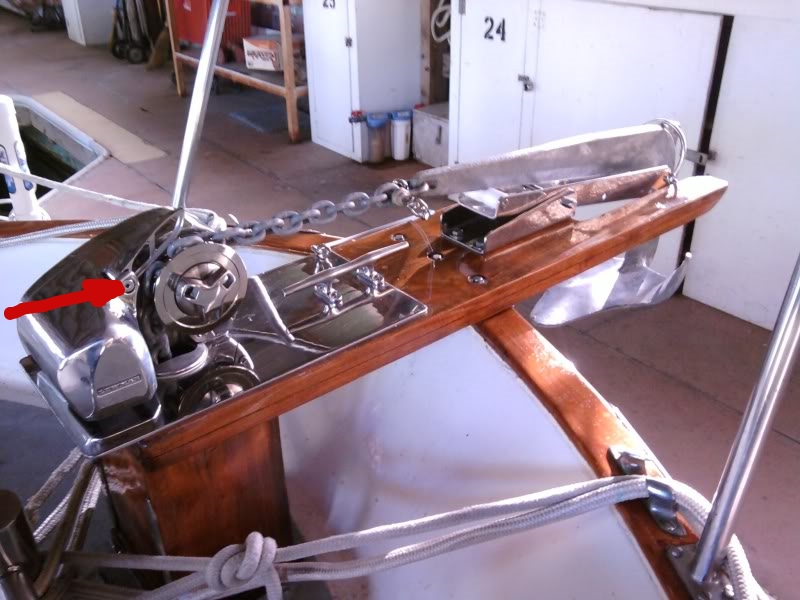- Joined
- Apr 15, 2008
- Messages
- 13,731
- Location
- California Delta
- Vessel Name
- FlyWright
- Vessel Make
- 1977 Marshall Californian 34 LRC
I'm trying to install my replacement rope guard on my Lewmar Windlass as part of a warranty upgrade kit. The instructions in the attached pdf file call for removing the old cap screw to replace the arm and install the new cap screw. The red arrow in the photo shows the location of the cap screw which is the pivot point for the arm.
Sounds easy enough, right?

The flush mounted cap screw has Loctite thread compound to keep it from loosening. As instructed, I applied moderate heat from a heat gun and attempted to loosen the screw with an allen wrench tip in a small 4 inch socket handle. As I increased force on the wrench, the allen tip snapped and is now stuck in the head of the cap screw, nearly flush with the screw head. A small 1-2mm portion of the severed tip is protruding beyond the screw head.
Now I've got a seized recessed screw head with a broken tip in the allen slot.

My thought is to use a small butane torch to heat the screw head in the hope that it will expand just enough to release the broken wrench tip. I might have just enough exposed tip to pull it from the slot with a fine needle nose pliers. I'd need to be careful not to heat the surrounding windlass casing to the point of discoloration. If I can get the tip out, I'd continue with the localized butane flame to release the screw with another allen head tip.
If this doesn't work, another thought I had was to carefully use a grinder to grind a slot into the head to allow me to use a large slot screwdriver to remove the screw....or even a notch on one side of the head that I could place a chisel into to pound in a CCW rotation. My concern is being able to control the grinder enough to get an accurate slot and not cause collateral damage to the stainless case.
But before I do this, I thought I'd run it past you guys who have a lot more experience in all things mechanical. Any suggestions or helpful tips?
Thanks much for your assistance!!
Sounds easy enough, right?

The flush mounted cap screw has Loctite thread compound to keep it from loosening. As instructed, I applied moderate heat from a heat gun and attempted to loosen the screw with an allen wrench tip in a small 4 inch socket handle. As I increased force on the wrench, the allen tip snapped and is now stuck in the head of the cap screw, nearly flush with the screw head. A small 1-2mm portion of the severed tip is protruding beyond the screw head.
Now I've got a seized recessed screw head with a broken tip in the allen slot.


My thought is to use a small butane torch to heat the screw head in the hope that it will expand just enough to release the broken wrench tip. I might have just enough exposed tip to pull it from the slot with a fine needle nose pliers. I'd need to be careful not to heat the surrounding windlass casing to the point of discoloration. If I can get the tip out, I'd continue with the localized butane flame to release the screw with another allen head tip.
If this doesn't work, another thought I had was to carefully use a grinder to grind a slot into the head to allow me to use a large slot screwdriver to remove the screw....or even a notch on one side of the head that I could place a chisel into to pound in a CCW rotation. My concern is being able to control the grinder enough to get an accurate slot and not cause collateral damage to the stainless case.
But before I do this, I thought I'd run it past you guys who have a lot more experience in all things mechanical. Any suggestions or helpful tips?
Thanks much for your assistance!!

 .
.